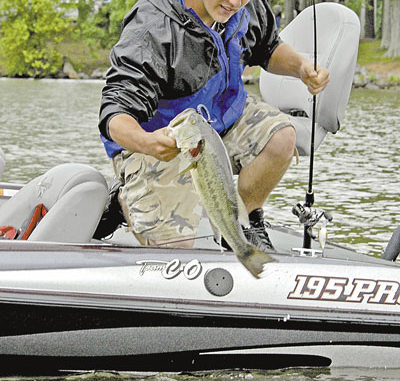
I enjoy fishing Lake D’Arbonne near West Monroe. During April, some of the bass at D’Arbonne still will be bedding. To catch the most and the biggest bass at D’Arbonne in April, watch for the shad spawn. Usually at some time from the middle to the latter part of this month, the baitfish will spawn on D’Arbonne’s cypress trees and stumps. So, I’ll fish shallow this month.
You’ll need to be on the water ready to fish early. Then when just a hint of daylight appears in the sky, start searching for shad. The shad spawn at night, so they won’t all get eaten while they’re trying to spawn. When the shad start spawning, they forget about everything else that’s happening, including their need to dodge bass. Also, catfish and crappie will be gorging themselves on those spawning shad right at first light.
I like two lures for this first hour of daylight — spinnerbaits and crankbaits. You’ll be able to see those shad spawning, but if you can’t spot them, begin casting a spinnerbait at stumps, logs and anything else sticking out of the water at daylight and reeling it slowly. You may spot an entire school of shad chasing that spinnerbait, and the bass fishing will be phenomenal. You may catch and release as many as 20 in an hour. However, that bite will last only for about an hour in the early morning. Once the shad quit spawning, the bass fishing will slow down, although it still can be good. You just won’t catch bass nearly as quickly or in as great numbers as you’ve caught that first hour of daylight.
I like to use a medium to slow retrieve with a 1/2-ounce white (my primary April color) spinnerbait with two willowleaf blades — one gold and one nickel. I like to mix the colors of my blades at this time of year to give the spinnerbait a different look. You’re trying to attract the shad because if you’re running at the right speed, a school of shad will follow your spinnerbait back to the boat, and the shad will draw in the bass. When the bass come after the shad, they’ll actually eat the spinnerbait.
I’ll also fish a white/chartreuse and sexy shad-colored spinnerbait — something that resembles a shad.
My favorite areas to fish the spinnerbait are around cypress trees, grass stems and lily pad stems. A lot of those big female bass will stay in that shallow water, even after they’ve spawned, waiting on the shad spawn. Then they can feed heavily and regain their weights. However, the female bass you catch won’t be as fat or as pretty in April as they were earlier.
Although shallow, the bass will be schooled up on certain cypress trees just like they are when they move out to deep water and school up on certain drops and deep ledges. The bass may have spawned in 1 or 2 feet of water, but this month they may have pulled out to those cypress trees and stumps in 3 to 4 feet of water. I’ll look for a big log or a tight group of trees to locate bunched-up bass. You may fish through several cypress trees and not get a bite. But then suddenly you may hit a school and catch various sizes of bass.
My second choice for daylight bass fishing will be a Strike King Series 4 crankbait in sexy shad. I’ll alternate between a spinnerbait and the Strike King Series 4 crankbait because I can cast back to the bass I’ve missed with the spinnerbait and catch them with the crankbait.
The shad won’t be attracted to the crankbait like they are to the spinnerbait. However, since the crankbait has a loud rattle, it appears to be a different type of shad. The bass can single that sound out and often will eat the crankbait instead of the shad.
After the first hour of daylight, I’ll start fishing my 1/2-ounce Hack Attack Jig in the sexy craw color, which looks like a bluegill or some type of perch, on 50-pound-test Cajun Braid. I fish the jig much more slowly than I do the spinnerbait or crankbait. The biggest bass generally are the first group to quit spawning. If the day’s cloudy, I like a black/blue jig.
You want the bass to take the jig as soon as it hits the water. During April, more of the bass will be holding in the roots of the trees than will be suspending above the roots. I think most of the bass, especially the bigger fish, already have gorged themselves during the shad spawn. Now they’ll be lying around the bottom. I’ve got to trick them into biting, because they’re not really hungry.
I try to fish around every cypress knee and the roots that are out away from the trunk of the tree. The water at D’Arbonne will have enough color in it that this heavy braided line won’t spook the fish. You’ll need the strength of that 50-pound-test line when you stick one of those big D’Arbonne bass that’s down in the roots of those trees.
At D’Arbonne this month, you may catch 20 bass and perhaps all of them in that first hour of daylight. Or you may have to fish all day to get 20 bass. But I expect to catch 8 to 10 good-sized bass for a day of fishing at D’Arbonne in April, and I’ll have a very good chance at catching a 6- to 7-pounder. In the last couple of years, D’Arbonne has given up some 10-plus-pound bass.


